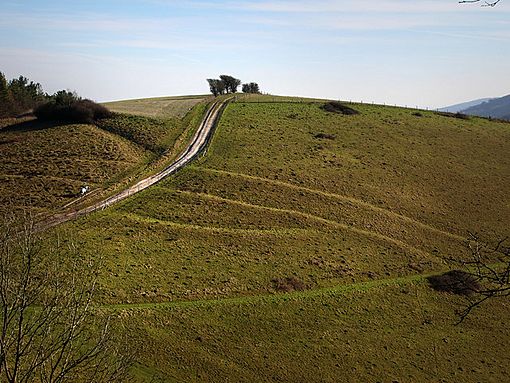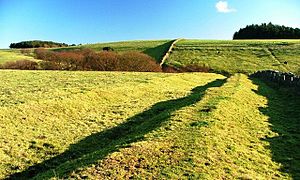Cross dyke facts for kids

A cross dyke is an ancient earthwork. It's like a long, low wall or ditch built a very long time ago. People think these were used as boundaries in prehistoric times. They are usually between 0.2 and 1 kilometer (about 0.1 to 0.6 miles) long. A typical cross dyke has one or more ditches running next to one or more raised banks.
Some cross dykes have a single ditch and bank (called univallate). Others have multiple ditches and banks (called multivallate). A key feature is that they cut across the top of a hill or a narrow part of a hill. You usually find them on high ground, over 150 meters (about 490 feet) above sea level.
Contents
What Were Cross Dykes Used For?
Cross dykes were built over about a thousand years. This started in the Middle Bronze Age (around 1500–1000 BC). Experts have different ideas about why they were built. Some think they were for defense. Others believe they were paths for cattle or just simple trackways.
Today, most experts think they were used as land boundaries. They also seem to have been used to mark internal areas within a territory. In southern England and Scotland, you often find cross dykes near hill forts. These dykes acted like control barriers. They were a common way to manage land in the uplands across Britain.
Sometimes, cross dykes blocked the paths leading to ancient settlements like hill forts. Since animals could easily go around them on steep slopes, these dykes likely aimed to stop people. One archaeologist, Andrew Fleming, suggested that cross dykes in Yorkshire might have been built in the Iron Age (around 800 BC – AD 100). He thinks they were meant to stop cattle raids.
Where Can You Find Cross Dykes?
About 90 cross dykes have been found in England. However, many more might have disappeared due to farming. Some might also be wrongly called "short linear earthworks." You can find cross dykes across northern and western England.
There are three main areas where many cross dykes exist. These are in Yorkshire, Wessex, and an area covering the Cotswolds and Shropshire. They are also common on the South Downs, where they often cut right across the chalk hills. In southeastern Scotland, cross dykes are extra defenses for hill forts in the Cheviot Hills. You can also find them in Wales.
Because there are not many left, and they show how land was used in the Bronze Age, well-preserved cross dykes are very important.
What Did Cross Dykes Look Like?
When they were first built, cross dykes with a single bank (univallate) likely had a stone bank. This bank might have had a wooden fence or palisade on top. Sometimes, there was also a ditch. Digs by archaeologists show that the banks were made of rubble. Some even had stone facing on the outside. Some banks might have had hedges growing on them.
Single-banked cross dykes would not have been very hard to cross. However, cross dykes with multiple banks and ditches (multivallate) would have been much harder to get past.
Cross dykes were much bigger when they were new. In areas where people farmed, the banks have worn down. The soil from the banks has filled the ditches. Now, often, only a shallow dip in the ground remains. For example, at East Toft in North Yorkshire, 0.4 kilometers (about 0.25 miles) of a dyke has completely vanished because of farming. But on moorland, cross dykes often still stand out as clear earthworks, like at Danby Rigg in North Yorkshire.
In Scotland, the cross dykes in the Cheviot Hills usually have one ditch. They have a bank on one or both sides. If there are two banks, one is usually taller than the other. At Woden Law, five cross dykes were built across the ridge. This ridge connected a hill fort to the main Cheviot hills. Later, Roman engineers built their road, Dere Street, across the same narrow piece of land.
How Old Are Cross Dykes?
Most cross dykes on the South Downs in southern England are thought to be from the late Bronze Age (around 1000 – 700 BC) or early Iron Age (around 700 – 400 BC). But one cross dyke at Chanctonbury Ring in West Sussex was found to be from the Roman period (AD 43 – 410). This is the only known cross dyke from such a late time.
Archaeologists often guess the age of cross dykes based on other ancient sites nearby. These might include stone circles or Iron Age farm systems. However, this way of dating isn't always exact. Some cross dykes might have been used into the Middle Ages (AD 410 – 1485). A few might even have been built then. Some cross dykes have continued to be used as boundaries right up to modern times. They sometimes match up with old parish boundaries.
At the Devil's Dyke in Sussex, an Iron Age hill fort used an older cross dyke as part of its wall. It also completely surrounds another cross dyke. Digs at several cross dykes north of Bokerley Dyke in Dorset showed they were from the Late Iron Age. The archaeologist thought they were boundaries for settlements.
Not many objects have been found during cross dyke excavations. Usually, it's just a few pieces of pottery, animal bones, and stone tools. The way the banks were built has protected the ancient ground surface underneath. This old surface is very important for archaeologists to study. In southern Wales, some cross dykes in the Rhondda Valley have been dated to the 8th–9th centuries AD, in the Early Middle Ages.
See also
- Neck ditch – a defensive ditch cut across the narrow part of a hill as part of a medieval spur castle's defenses.



